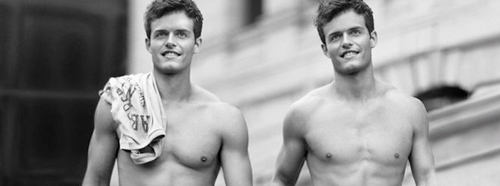
Every morning, a bonfire burns in a 300-acre wooded compound in New Albany, Ohio. Dance music — the throbbing, reverb-heavy kind you hear at circuit parties — plays from every one of the tin-roofed buildings. In a room whose glass wall faces the immaculately kept grounds, a man with bleached blond hair stands barefoot, pumping iron to the beat.
Is it a cult? A gay fitness retreat?
No, it's the Abercrombie & Fitch headquarters, and the solitary weightlifter is Michael Jeffries, its resident impresario and CEO. Jeffries is now 63, but has made a religion of looking like the brawny Aryan specimens who constitute A&F's core demographic.
For example: When asked why he dyes his hair such a distinctly unnatural shade of platinum, Jeffries replied, "Dude, [because] I'm not an old fart who wears his jeans up at his shoulders."
Though analysts periodically prophesy the company's impending demise (and never without a touch of Schadenfreude), A&F shows no signs of collapsing; even in the current downbeat market, revenues are approaching $4 billion.
This is particularly remarkable given the fact that A&F has always been unapologetically elitist — indeed, almost eugenic — in its brand image. This is largely Jeffries' doing:
In his words, Abercrombie "[goes] after the cool kids… A lot of people don't belong [in our clothes] and they can't belong… That's why we hire good-looking people… Because good-looking people attract other good-looking people… We don't market to anyone other than that."
Beyond its snobbish marketing, maybe Abercrombie owes its success to Jeffries' unique superstitions. He parks his Porsche at the same angle in the company parking lot every day and leaves the car unlocked, with the keys prominently displayed on the front seat.
Before looking at the firm's numbers each morning, Jeffries dons the same pair of "lucky shoes," which he keeps in his secretary's desk. When the sole of one fell off somewhere on the grounds, every staff member was on the hunt for it until it was found.
While Jeffries "is probably insane," at least according to a former coworker, he's also "unbelievably driven and brilliant." That Jeffries was able to turn a retailer once best-known for selling bass lures and hip-waders to President Eisenhower into a multibillion-dollar cult brand attests to this fact, as does the fact that no less a brand guru than Ralph Lauren thought Jeffries' ideas were good enough to steal. Rugby, the preppy chain Lauren launched in 2004, owes more than a little to A&F's softcore-porn-meets-polo-mallet aesthetic.
Of course, A&F hasn't always opted for such comparative subtlety. The company has drawn fire for a number of their t-shirt slogans, including "Gentlemen Prefer Tig Ol' Bitties" and "Who Needs a Brain When You Have These?" Not to mention thongs aimed at little girls and emblazoned with the words "Eye Candy" and "Wink Wink."
Jeffries, for his part, "still [thinks] those are cute underwear for little girls" and has said that he "really [doesn't] care what anyone other than our target customer thinks."
What does> upset the seemingly unflappable CEO are charges that A&F's advertising is homoerotic: The firm's now-defunct quarterly catalogue was designed by gay icon Bruce Weber and featured chiseled boys playfully tugging at one another's Abercrombie boxers.
And Jeffries himself, according to Business Week, has a Herb Ritts photo of a naked male torso hanging over the fireplace in his bedroom. Jeffries has lived apart from his wife for years.
To Jeffries, regarding such things as being in some way gay is "just so wrong! [A&F's sexuality] is healthy. It's playful… It's not gay, it's not straight… It's not about any labels." What's more important is controlling every aspect of the brand's image: Jeffries says he's "obsessed" with the following questions: "How does a store look? How does it feel? How does it smell?"
All of Abercrombie's stores, for the record, smell like FIERCE, their not-at-all-gay-sounding men's cologne.
Share